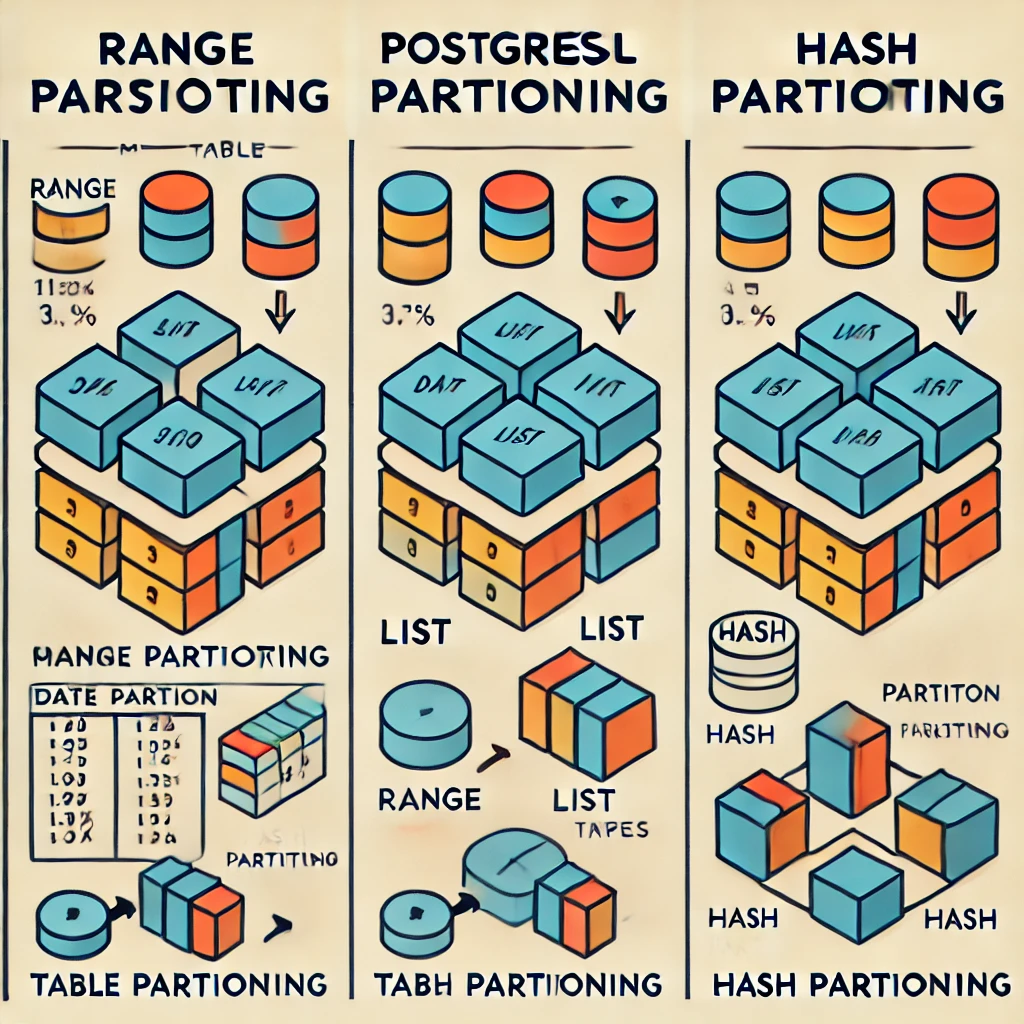Introduction
As data grows, managing it efficiently becomes one of the biggest challenges for applications. PostgreSQL, a popular open-source database, offers a solution called table partitioning to help handle large datasets. Table partitioning is like dividing a massive table into smaller, more manageable pieces. This can make a big difference in how quickly and smoothly the database responds to queries.
When you partition a table, you split it based on specific criteria, like dates, categories, or ranges. For example, imagine a table with millions of sales records—searching through all of those rows can take a lot of time. But if the table is partitioned by year or month, the database only needs to search the relevant part. This results in faster queries, less memory use, and better organization.
In this guide, we’ll explore how to set up table partitioning in PostgreSQL to improve performance. We’ll go over the types of partitioning available, how to create partitions, and practical examples to help you understand when and how to use this feature. By the end, you’ll have the tools you need to boost your database’s performance with PostgreSQL table partitioning.
What is Table Partitioning?
Table partitioning is a method in PostgreSQL that allows you to break a large table into smaller, more manageable pieces, called “partitions.” Instead of having all your data in one huge table, you divide it into several smaller tables, each holding a portion of the data. These smaller tables are still part of the main table, but the database treats them as separate units when it needs to search or store information.
Partitioning helps organize data in a way that makes it easier and faster to access. For example, let’s say you have a table with millions of rows tracking customer orders over many years. Searching through this huge table for recent orders would take time because the database has to look through all the rows, including older records. But if you partition this table by year, PostgreSQL can quickly narrow its search to just the rows in the current year’s partition, speeding up the query.
Partitioning is especially useful for large tables with time-based or categorized data, like logs, sales records, or customer information divided by region. By focusing on only the relevant partitions, PostgreSQL reduces the time and memory it needs to perform operations, making it easier for you to work with massive amounts of data. In short, table partitioning is a way to improve performance and efficiency in PostgreSQL by organizing your data more effectively.
What is Types of Partitioning in PostgreSQL
In PostgreSQL, there are different ways to divide data into partitions, depending on how you want to organize and access it. Each type of partitioning is designed to handle specific kinds of data organization. The main types are range partitioning, list partitioning, and hash partitioning.
Range partitioning is used when you want to split data based on ranges, like dates or numerical values. For example, if you have a table for storing monthly sales data, you could create partitions for each month or each year. When you query for sales data from a specific month, PostgreSQL only searches in that month’s partition, making it faster.
List partitioning works best when you need to divide data into specific, fixed categories. For example, if you have customer data from different countries, you could create partitions for each country or region. This way, a query looking for customers in a particular country only scans that country’s partition instead of the entire table.
Hash partitioning is useful when you want to spread data evenly across partitions but don’t have natural ranges or categories. In this type, PostgreSQL uses a hash function to assign rows to different partitions. This helps balance the load across partitions, which can be useful in cases where data doesn’t fit neatly into ranges or lists, like customer IDs or order numbers.
Each partitioning type has its advantages depending on the data and how you expect to access it. Range and list partitioning are often easier to set up and understand, while hash partitioning can be useful for even data distribution. Choosing the right type can make a big difference in how efficiently your database handles large volumes of data.
How to Create Partitions in PostgreSQL
Creating partitions in PostgreSQL involves setting up a main table as a “parent” and then creating smaller “child” tables as partitions. First, you define the main table with a special setting that tells PostgreSQL it will hold partitions, not data directly. This allows PostgreSQL to automatically send data to the right partition based on rules you set.
For example, let’s say you want to create a table to store sales records for each month. You would start by creating a parent table for all sales data, but instead of holding data itself, this table will be structured to route data to specific monthly partitions.
Here’s what creating partitions might look like in practice:
1. Create the parent table: You define a table, such as sales_data, and specify a partitioning method. This could be by range (for dates) or by list (for specific categories).
In this example, sales_data is the main table for tracking sales. The PARTITION BY RANGE statement tells PostgreSQL that data should be divided into partitions based on date ranges.
2. Create child tables for each partition: Next, you create child tables to hold data for specific date ranges. For instance, you could create one partition for each month.
This command creates a partition for January 2024, meaning that any sales records dated in January will automatically go to this partition. You can continue creating partitions for each month or year as needed.
3. Add partitions as data grows: If your data keeps growing, you can continue adding partitions over time. Many PostgreSQL users set up scripts to automatically create new partitions on a schedule, like every month, to keep up with new data.
By organizing data into partitions, queries can focus on only the relevant partitions, making database operations faster and more efficient. Creating partitions may feel complex at first, but once you set up the initial parent table and a few partitions, PostgreSQL handles the rest.
Inserting Sample Data and Visualizing the Queries
To see how the data is stored across partitions, you can use a simple SELECT statement:
This query will retrieve all data from sales_data, showing records from both the January and February partitions.

Perform Aggregate Queries
Monthly Sales Totals to see sales for each month separately:

Average Sales per Day in January:

Apply Range Partitioning to an Existing Table
Before applying the Range partition, we will create new table and insert some sample data. After that we will apply the Range Partition.
Step 1: Create the sales_data Table
Step 2: Insert Dummy Data
Now, let’s insert some sample data into this table. We’ll add data across several months to create a dataset that’s ideal for testing range partitioning.
Now we’re all set to apply range partitioning. We need to follow the below steps:
1. Create a New Partitioned Table
First, create a new table with the same structure as the existing table, but include partitioning using the PARTITION BY RANGE clause.
2. Create Partitions for the New Table
Set up the necessary partitions for the new partitioned table.
3. Transfer Data from the Existing Table to the New Partitioned Table
Use the INSERT INTO … SELECT … statement to move data from the existing table into the new partitioned table. This will automatically direct each row to the appropriate partition based on the range specified.
4. Rename Tables
Once the data transfer is completed, we can rename the tables. Optionally, rename the original table (e.g., sales_data_old) and then rename new_sales_data to sales_data.
5. Drop the Old Table (Optional)
After verifying that the data was transferred correctly, we can drop the original table if it’s no longer needed.
Notes
• Indexes and Constraints: Re-create any indexes or constraints from the original table on the new partitioned table or its partitions, as they aren’t automatically copied.
• Downtime Considerations: This process may require some downtime or a maintenance window if the table is large or if the application requires continuous access to the data.
• Data Verification: Always verify the data to ensure a smooth transition.
Managing Partitions
After setting up partitions, it’s important to know how to manage them over time. In PostgreSQL, managing partitions involves tasks like adding new partitions as data grows, removing old ones to save space, and keeping partitions organized. These tasks ensure that the database stays efficient and continues to perform well as your data changes.
One common management task is adding new partitions. For example, if you’re partitioning by date, you may need to add a new partition every month or year. If your main table stores monthly sales data, you would create a new partition at the beginning of each month to capture that month’s data. You can do this manually, or you can set up a script to add partitions automatically on a schedule. This way, your database is always ready to handle new data without interruptions.
Another task is removing old partitions when they are no longer needed. For instance, if you only need to keep sales records for the last two years, you can drop older partitions to save space. This is especially helpful when working with large tables, as old data can quickly take up storage and slow down the database. By removing outdated partitions, you keep the database lean and focused on the data you actively use.
Partition management can also include tasks like reindexing partitions to keep searches fast, or vacuuming partitions to clear out deleted rows and free up space. These maintenance tasks can often be scheduled to run automatically, keeping the database healthy with minimal effort.
Example Use Case: Optimizing Performance with Range Partitioning
Imagine you’re managing a large online store that has been operating for several years. The store has a table, sales_data, that stores information about each sale, including the date, product details, and amount. Over the years, this table has grown to include millions of rows, making queries slow and memory-intensive, especially when you’re only interested in recent data.
One way to improve performance is to use range partitioning. Range partitioning divides the sales_data table into smaller sections (partitions) based on a date range, such as by month or year. This way, when you query for recent sales, PostgreSQL can limit its search to only the relevant partition, skipping over older data entirely. This reduces the workload and speeds up response times.
To start, you’d create a parent table for sales_data and then add partitions for each month. For example, if you’re partitioning by month, you might create partitions named sales_data_2024_01, sales_data_2024_02, and so on. When a new sale is added, PostgreSQL automatically places it in the correct partition based on the date.
Let’s say you want to analyze recent sales trends for the past three months. Without partitioning, PostgreSQL would scan the entire sales_data table, even though most of that data is irrelevant to your query. With range partitioning, PostgreSQL only looks at the partitions for the past three months, ignoring all older partitions. This focused search reduces query time, improves memory efficiency, and makes the database more responsive.
Partitioning also helps with data management. Suppose you no longer need sales data from five years ago. With partitions, you can easily drop the old partitions without affecting the rest of the data. This keeps the database lean, with only the data you actually need.
When Not to Use Partitioning
While partitioning can boost performance for large tables, it’s not always the right solution. In fact, partitioning may complicate things unnecessarily if the table doesn’t have a huge amount of data. If a table is relatively small, the benefits of partitioning are minimal because PostgreSQL can already handle the data efficiently. Adding partitions could even slow things down by adding overhead, as PostgreSQL has to check each partition during a query.
Partitioning is also less helpful if you frequently need to access all the data in a table, rather than a specific subset. For example, if your application constantly requires the entire dataset, partitioning won’t reduce the workload because PostgreSQL still has to go through each partition to retrieve all the data. In such cases, partitioning may increase complexity without improving performance.
Additionally, partitioning is not ideal for tables with unpredictable or random data distribution. Suppose you have a table where data doesn’t follow a clear pattern, like user activity logs with random timestamps. With this kind of data, it’s hard to define meaningful partitions, and queries may end up scanning all partitions anyway. Without a clear partitioning strategy, the partitions won’t align well with the queries, limiting performance benefits.
Lastly, partitioning isn’t always the best choice for tables with frequent updates or deletes. Each partition behaves like a separate table, so updating or deleting data across multiple partitions can become complex. Managing partitions, reindexing, and running maintenance tasks could add more overhead than benefit if your data is constantly changing.
Conclusion
In conclusion, table partitioning in PostgreSQL is a powerful tool that can significantly boost performance, especially when working with large datasets. By dividing a big table into smaller, manageable pieces, you allow PostgreSQL to quickly locate and retrieve only the data it needs. This leads to faster queries, efficient memory use, and easier maintenance. Range partitioning, for example, is particularly helpful when dealing with time-based data, allowing you to focus on relevant portions without scanning the entire table.
However, partitioning is not always necessary. For smaller tables or those that don’t have a natural way to split data, partitioning can actually complicate things. It’s most effective when you have a clear partitioning strategy, such as splitting data by time or category, and when you regularly need to access only a subset of your data.
Understanding when to use partitioning and how to set it up properly is key to getting the best results from your PostgreSQL database. With careful planning, partitioning can make your database faster, more organized, and easier to manage. Whether you’re working with logs, historical records, or other growing datasets, partitioning is a tool worth considering for long-term database health and performance.
To sum up, table partitioning gives you flexibility and efficiency, helping PostgreSQL handle large data smoothly and reliably.



